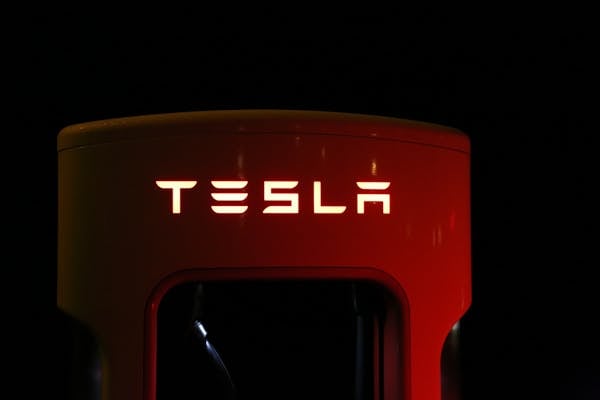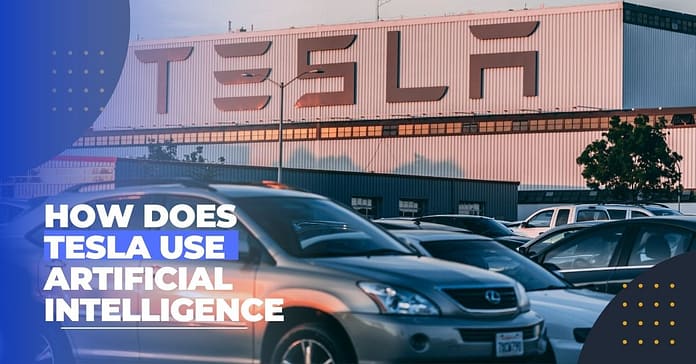-How does Tesla use Artificial Intelligence? Elon Musk’s corporate headquarters are getting data, including over 500,000 Teslas worldwide, to train their algorithms for autonomous cars. These findings offer Tesla a considerable advantage in increasing the number of electric vehicles on the road.
When visitors think of Tesla, you might assume they are a typical automaker. Without question, Tesla is a leader in the industry of electric vehicles. But the key to their success is that they are a tech business. The fact that their business was established using artificial intelligence technology is one of the elements that has contributed to their success.
Tesla’s primary goal regarding artificial intelligence
One of Tesla’s primary goals is to have fully autonomous vehicles, and they are working towards this goal by utilizing big data and AI.
How does Tesla use Artificial intelligence?

- Intelligence Is Tesla’s Key Technology
Since its inception, Tesla has profited from customer data, and its work on automated cars is part of its ongoing mission to put AI at the heart of its processes. Elon Musk and his Tesla team will depend on AI and big data as they progress with their newest endeavors.
Electric drive Tesla motors
Tesla Motors, a 2003-founded electric drive and green energy company headquartered in California, is currently valued at over $700 billion, surpassing the total value of the top six automakers. Although Tesla is best known today for its hybrid vehicles, the company also makes autonomous power generation and storage products, including solar cells, solar roof tiles, and other items, to help “homeowners, businesses, and utilities manage the generation of clean energy, storage, and consumption.”
- Tesla’s mission and AI usage
Tesla aims to “accelerate the worldwide transition to sustainable energy.” More than 1.5 billion of its electric vehicles were shipped in 2020, exceeding the production cap of 1 million units. Additionally, in the same year, Tesla recorded the highest revenue in the battery and plug-in electric passenger car segments.
How does Tesla use Artificial intelligence? Use cases
- Computer Vision for Autopilot
AI describes how Tesla employs PyTorch to create, train, and improve the neural networks designed to enable Autopilot technology in its cars. Opticaster’s tracking How Tesla uses Artificial Intelligence electricity assets – Opticaster is one of the applications developed by the Nikola Energy division. It is a part of the business’s Autonomous Control suite, intended to increase energy control, storage, and efficiency.
- AI autopilot using visual intelligence
Tesla claims Autopilot is a driving aid to improve customer convenience and safety. When used correctly, the system can help the driver exert less overall. Computer vision is part of a broader group of AI apps that make up Autopilot. Autopilot users can presumably drive more safely while taking advantage of self-convenience. driving’s
Each brand-new Tesla vehicle comes with Autopilot technology in addition to “8 different cameras, 12 scanners, and a potent onboard computer,” the company claimed. Five distinct models are available from the company. Autopilot relies on these cameras and sensors because, unlike its competitors, it does not interact with the surroundings using Light Recognition, Ranging (LiDAR), and elevated maps.
Purpose of computer vision use in Tesla
The fact that Tesla gathers all of the data from its vehicles to continue improving and refining its deep neural network algorithms is one reason why the company is the only major automaker to concentrate on computer vision rather than LiDAR. At a conference in 2019, Tesla’s Director of Intelligence and Computer Vision, Andrej Karpathy, said that the business is vertically integrated generally, How does Tesla use Artificial Intelligence, and the same apply to Autopilot intelligence?
It uses the data to “train GPU clusters, and then we take it via the entire stack. We operate these connections on our own and converted them into new something which we grow internally. Then we deploy them to our fleet of almost 3 hundred million cars, look at satellite measurements, and try to improve the feature[s] over time.” The company is building its cars, installing sensors on each one, collecting and labeling all the data, and using it.
Karpathy threw in.
He claims his team trained “hydrants,” or multi-headed neural networks, using PyTorch to scan and gather data (pictures) for road boundaries, stop signs, obstacles, vehicles, and how Tesla uses Artificial Intelligence potential interaction sites.
He gives an example of how the human mind generates a route layout prediction:
Tasks requiring synchronous operation on several images are widespread. For instance, if you’re trying to predict how roads will be laid out, you might need the right features from many other hydrants. To develop a kind of road layout prediction, you may wish to add some traits to these hydrants and analyze them a second time, potentially repeatedly.
According to Tesla, the Autopilot system has several features, including Pilot guidance, Autosteer, Smart Recall, Autopark, and more. The company offers guidance on using these functions safely while on a motorway.
Toyota’s safety report
According to Toyota’s Q4 2020 Safety Report, only one accident was recorded for every 3.45 billion dollars of miles driven while using Autopilot. The corporation continued,
“We recorded one accident for every 2.05 billion miles driven by those not using Automation, including using our safety devices in reaction. How does Tesla use Artificial Intelligence? We observed one accident for every 1.27 million kilometers driven by those not utilizing Autopilot or with our active safety features. According to the most recent NHTSA data, a car accident happens in the US every 484,000 miles.
Monitoring Energy Assets with Opticaster
According to the company, the software Tesla calls “Autonomous Control” uses computer vision, predicting, optimization, and others to benefit its users in various ways, from reducing energy costs to enabling remote microgrid control. Autobidder, Powerhub, Microgrid Controller, and Opticaster are four separate software programs.
Final words
The goal of Opticaster, which Tesla describes as “the fundamental computational modeling and efficiency engine for Tesla energy software,” is to optimize the financial gains from distributed energy sources while preserving their long-term viability. In more detail, it is claimed that the software suite will reduce energy consumption at the site level and allow users to use their energy supplies “to provide valuable services to the grid.”
Read Also: How To Get into Artificial Intelligence

